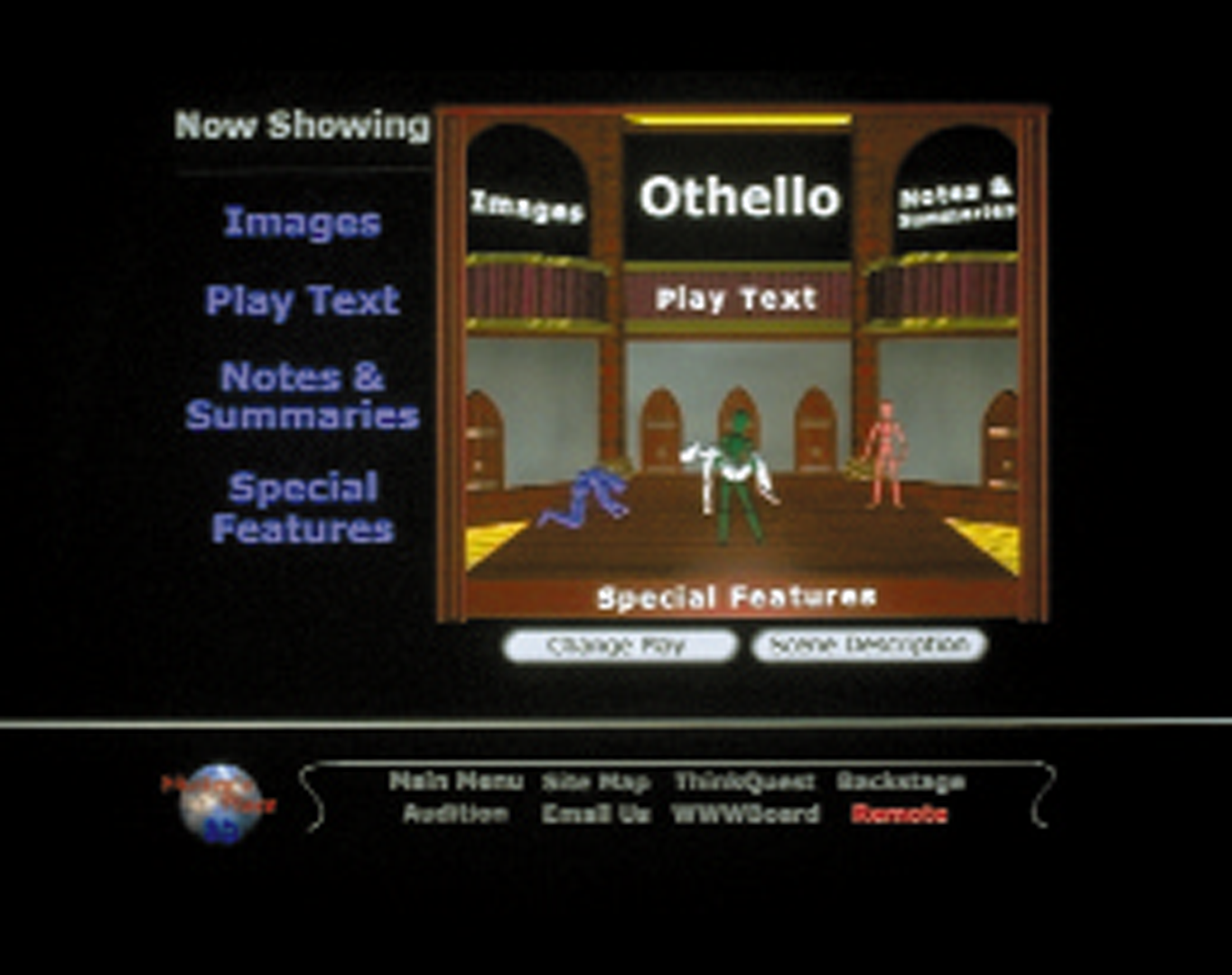“SP3D and the Lighthouse: Explorations in 3D Internet Learning” by Hall
Conference:
- SIGGRAPH 1999
-
More from SIGGRAPH 1999:


Type(s):
Title:
- SP3D and the Lighthouse: Explorations in 3D Internet Learning
Program Title:
- Electronic Schoolhouse (Classroom, Playground)
Organizer(s)/Presenter(s):
Description:
Introduction
In most classrooms, subjects such as Shakespeare and philosophy are associated with the words “boring,” “haughty,” and even “incomprehensible.” Using the Internet and
3D graphic technology, students can now be transported to a 3D interactive world where these subjects become “real.”
Shakey’s Place 3D (library.advanced.org/10502/index.htm) and The Lighthouse (library.advanced.org/18775/index.htm) are Web sites designed to breathe life into Shakespeare, philosophy, and the students who study them. The sites’ use of 3D graphics creates striking environments meant to peak interest and increase the educational value of the interactive devices they contain.
Background
In 1996, three students decided to attempt to free students from “painful” lectures and readings about Shakespeare by creating a 3D world that any student could visit and, more importantly, learn from. As part of the ThinkQuest Project, William Shakespeare’s Globe Theatre was rebuilt in 3D and placed online. Students and teachers alike could visit and understand that Shakespeare, although a stereotypically boring subject, could be interesting. The result: Shakey’s Place 3D.
SP3D was a success, not only in the ThinkQuest Project, but also in its intent. It received second place in the ThinkQuest competition, earning $48,000 dollars in scholarships and grants. More than three million visits have been logged since its release in August 1997.Teachers, students, academics, and enthusiasts have walked through the theater, and its influence is still growing.
With the success of SP3D, the idea was expanded to philosophy, as a new entry in the ThinkQuest contest:The Philosophers’ Lighthouse. Here, the graphics were improved, and, once again, a topic was revitalized with 3D technology and Web design.The Lighthouse has prompted a great amount of discussion and response since its release in August 1998 and has been selected as an Honorable Mention in the 1998 ThinkQuest contest.
In-Depth
The success of these Web sites has prompted a new method of teaching students, where field trips can be an inexpensive treat, where new ideas are bolstered and encouraged, even where collaborative study moves beyond the boundary of the classroom and on to a global realm. As Shakey’s Place decrees in its introduction: “It’s not what you need to learn… it’s what you are inspired to learn. “The worlds created in these sites draw the user in beyond the boundary of stereotypical “forced” education. Users are enticed further into the site, to explore. They can then use the tools without pressure or boundaries, thereby strengthening the educational value of the interactive devices. A few of these devices include:
• Madlibs (SP3D), where users are prompted to type random words, then the Web site replaces keywords in, for instance, a soliloquy by Hamlet with the random words provided. This shows the importance of iambic pentameter, poetic meter, and especially how words “paint” emotions. It is a perfect example of “effortless retention.” Students are much more likely to remember if they have a “fun” example to remember, rather than just their notes.
• Online Auditions (SP3D), where users choose a “face” from a gallery of graphics, then decide which part they would like in which play. This creates not only a one-on-one relationship with the student, but also provides teachers and researchers statistics on which characters certain age groups associate with. Thus, not only does the Web site create a personal link with visitors, but it also gives teachers that opportunity as well
.
• Voting Booths (Lighthouse), where visitors can vote on which philosophy or philosopher makes the most sense to them. This gives value to visitors’ opinions and causes them to think, compare, and contrast, then vote.
• Bulletin Board Systems (both Web sites), where visitors are encouraged to collaborate on topics and formulate opinions. These bulletin boards broaden the horizons of the sites, perhaps even bringing to light topics that were not approached on the sites before.
These tools would be useless, however, without a strong hook to interest the user. The 3D environments draw the user in by making navigation easy, minimizing unnecessary reading, and simulating a field trip. Teachers can lead their students into a computer lab or classroom and walk them through an exciting world, teaching them and entertaining them at the same time. Enthusiasts of all ages can research or discuss their topics without being slowed by continual searching or reading. SP3D and The
Lighthouse also use technology to encourage users to respond in a way that other sites and media cannot offer. These sites do not tell users what to think. SP3D and The Lighthouse bring a whole new meaning to the word “interactive.”
Plans
Using the same concept, these principles of design and education are being applied to another site. In this trio of sites, each site will be unique in its subject matter, but they will share the same ideal: using 3D graphics as an interface to bring difficult or unpopular subjects to light. The new site is displayed alongside SP3D and The Lighthouse as a case study, to show how these sites come into existence.
The software, hardware, and World Wide Web issues involved are explored in an effort to encourage similar efforts and use of the Web in education. Perhaps someday trips to ancient Rome, colonial America, or even mystical Atlantis will be possible from a classroom, and learning will be inspired, not required.




